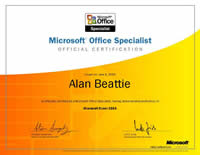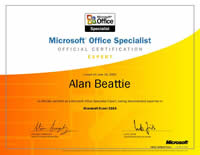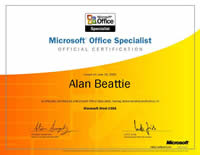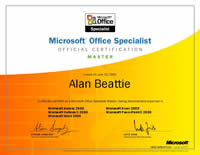Microsoft Office Specialist 2000




Certifications

Microsoft Office Specialist: Access 2000

Microsoft Office Specialist: Excel 2000

Microsoft Office Specialist: Excel Expert 2000

Microsoft Office Specialist: Outlook 2000

Microsoft Office Specialist: PowerPoint 2000

Microsoft Office Specialist: Word 2000

Microsoft Office Specialist: Word Expert 2000

Microsoft Office Specialist: Master 2000

Microsoft Office Specialist: Master Instructor 2000
Skills
Word 2000
Working with Text
- Use the Undo, Redo, and Repeat commands
- Apply font formats (bold, italic, and underline)
- Use the Spelling and Grammar command
- Use the Thesaurus
- Insert page breaks
- Highlight text in document
- Insert and move text
- Cut, copy, paste, and paste special using the Office Clipboard
- Copy formats using the Format Painter
- Select and change font and font size
- Find and replace text
- Apply character effects (superscript, subscript, strikethrough, small caps, and outline)
- Insert date and time
- Insert symbols
- Create and apply frequently used text with AutoCorrect
Working with Paragraphs
- Align text in paragraphs (center, left, right, and justified)
- Add bullets and numbering
- Set character, line, and paragraph spacing options
- Apply borders and shading to paragraphs
- Use indentation options (left, right, first line, and hanging indent)
- Use Tabs command (center, decimal, left, and right)
- Create an outline-style numbered list
- Set tabs with leaders
Working with Documents
- Print a document
- Use print preview
- Use Web Page Preview
- Navigate through a document
- Insert page numbers
- Set page orientation
- Set margins
- Use GoTo to locate specific elements in a document
- Create and modify page numbers
- Create and modify headers and footers
- Align text vertically
- Create and use newspaper columns
- Revise column structure
- Prepare and print envelopes and labels
- Apply styles
- Create sections with formatting that differs from other sections
- Use Click and Type
Managing Files
- Use save
- Locate and open an existing document
- Use Save As (different name, location, or format)
- Create a folder
- Create a new document using a wizard
- Save as Web Page
- Use templates to create a new document
- Create Hyperlinks
- Use the Microsoft Office Assistant
- Send a Word document via e-mail
Using Tables
- Create and format tables
- Add borders and shading to tables
- Revise tables (insert and delete rows and columns and change cell formats)
- Modify table structure (merge cells, change height, and width)
- Rotate text in a table
Working with Pictures and Charts
- Use the drawing toolbar
- Insert graphics into a document (WordArt, clip art, and images
Excel 2000
Working with Cells
- Use Undo and Red
- oClear cell content
- Enter text, dates, and numbers
- Edit cell content
- Go to a specific cell
- Insert and delete selected cells
- Cut, copy, paste, paste special, and move selected cells
- Use the Office Clipboard
- Use Find and Replace
- Clear cell formats
- Work with series (AutoFill)
- Create hyperlinks
Working with Files
- Use Save
- Use Save As (different name, location, and format)
- Locate and open an existing workbook
- Create a folder
- Use templates to create a new workbook
- Save a worksheet/workbook as a Web Page
- Send a workbook via e-mail
- Use the Microsoft Office Assistant
Formatting Worksheets
- Apply font styles (typeface, size, color, and styles
- Apply number formats (currency, percent, dates, and commas)
- Modify row and column size
- Modify alignment of cell content
- Adjust decimal places
- Use the Format Painter
- Apply AutoFormat
- Apply cell borders and shading
- Merge cells
- Rotate text and change indents
- Define, apply, and remove a style
Page Setup and Printing
- Preview and print worksheets and workbooks
- Use Web Page Preview
- Print a selection
- Change page orientation and scaling
- Set page margins and centering
- Insert and remove a page break
- Set print, and clear a print area
- Set up headers and footers
- Set print titles and options (gridlines, print quality, and headings for rows and columns)
Working with Worksheets and Workbooks
- Insert and delete rows and column
- Hide and unhide rows and columns
- Freeze and unfreeze rows and columns
- Change the zoom setting
- Move between worksheets in a workbook
- Check spelling
- Rename a worksheet
- Insert and delete worksheets
- Move and copy worksheets
- Link worksheets and consolidate data using 3-D references
Working with Formulas and Functions
- Enter a range within a formula in a drag-and-drop operation
- Enter formulas in a cell and use the formula bar
- Revise formulas
- Use references (absolute and relative)
- Use AutoSum
- Use the Paste Function to insert a function
- Use basic functions (AVERAGE, SUM, COUNT, MIN, and MAX)
- Enter functions using the Formula Palette
- Use date functions (NOW and DATE)
- Use financial functions (FV and PMT)
- Use logical functions (IF)
Using Charts and Objects
- Preview and print charts
- Use the Chart Wizard to create a chart
- Modify charts
- Insert, move, and delete an object (graphic)
- Create and modify lines and objects
PowerPoint 2000
Creating a Presentation
- Delete slides
- Create a specified type of slide
- Create a presentation from a template or a wizard
- Navigate among different views (slide, outline, sorter, and tri-pane)
- Create a new presentation from existing slides
- Copy a slide from one presentation into another
- Insert headers and footers
- Create a blank presentation
- Create a presentation using the AutoContent Wizard
- Send a presentation via e-mail
Modifying a Presentation
- Change the order of slides using Slide Sorter view
- Find and replace text
- Change the layout for one or more slides
- Modify the Slide Master
- Modify slide sequence in the outline pane
- Apply a design template
Working with Text
- Check spelling
- Change and replace text fonts (individual slide and entire presentation)
- Enter text in tri-pane view
- Import text from Microsoft Word
- Change the text alignment
- Create a text box for entering text
- Use the Wrap text in Text Box feature
- Use the Office Clipboard
- Use the Format Painter
- Promote and Demote text in slide and outline panes
Working with Visual Elements
- Add a picture from the Clip Art Gallery
- Add and group shapes using WordArt or the Drawing Toolbar
- Apply formatting
- Add text to a graphic object using a text box
- Scale and size an object including clip art
- Create tables within PowerPoint
- Rotate and fill an object
Customizing a Presentation
- Add AutoNumber bullets
- Add speaker notes
- Add graphical bullets
- Add slide transitions
- Animate text and objects
Creating Output
- Preview presentation in black and white
- Print slides in a variety of formats
- Print audience handouts
- Print speaker notes in a specified format
Delivering a Presentation
- Start a slide show on any slide
- Use on screen navigation tools
- Print a slide as an overhead transparency
- Use the pen during a presentation
Managing Files
- Save changes to a presentation
- Save as a new presentation
- Publish a presentation to the Web
- Use the Microsoft Office Assistant
- Insert hyperlink
Access 2000
Planning and Designing Databases
- Determine appropriate data inputs/outputs for your database
- Create table structure
- Establish table relationships
Working with Access
- Use the Microsoft Office Assistant
- Select an object using the Objects Bar
- Print database objects (tables, forms, reports, and queries)
- Navigate through records in a table, query, or form
- Create a database (using a wizard or in-design view)
Building and Modifying Tables
- Create tables by using the Table Wizard
- Set primary keys
- Modify field properties
- Use multiple data types
- Use multiple data types
- Use the Lookup Wizard
- Use the Input Mask Wizard
Building and Modifying Forms
- Create a form with the Form Wizard
- Use the Control Toolbox to add controls
- Modify Format Properties (font, style, font size, color, caption, etc.) of controls
- Use form sections (headers, footers, and detail)
- Use a Calculated Control on a form
Viewing and Organizing Information
- Use the Office Clipboard
- Switch between object views
- Enter records using a datasheet
- Enter records using a form
- Delete records from a table
- Find a record
- Sort records
- Apply and remove filters (filter by form and filter by selection
- Specify criteria in a query
- Display related records in a subdatasheet
- Create a calculated field
- Create and modify a multitable select query
Defining Relationships
- Establish relationships
- Enforce referential integrity
Producing Reports
- Create a report with the Report Wizard
- Preview and print a report
- Move and resize a control
- Modify Format Properties (font, style, font size, color, caption, etc.)
- Use the Control Toolbox to add controls
- Use report sections (headers, footers, and detail)
- Use a Calculated Control in a report
Integrating with Other Applications
- Import data to a new table
- Save a table, query, or form as a Web page
- Add Hyperlinks
Using Access Tools
- Print database relationships
- Back-up and restore a database
- Compact and repair a database
Outlook 2000
Using Outlook 2000 to Communicate
- Read mail
- Send mail
- Compose mail by entering text
- Print mail
- Address mail by entering text
- Use mail features (forward, reply, and recall)
- Use address book to address mail
- Flag mail messages
- Navigate within mail
- Find messages
- Configure basic mail print options
- Work with attachments
- Add a signature to mail
- Customize the look of mail
- Use mail templates (themes) to compose mail
- Integrate and use mail with other Outlook components
- Customize menu and task bars
Using Outlook 2000 to Manage Messages
- Create folders
- Sort mai
- Set viewing options Archive mail messages
- Filter a view
Using the Outlook 2000 Calendar
- Navigate within the calendar
- Schedule appointments and events
- Set reminders
- Print in calendar
- Schedule multiday events
- Configure calendar print options
- Customize the calendar view
- Schedule recurring appointments
- Customize menu and task bars
- Add and remove meeting attendees
- Plan meetings involving others
- Save a personal or team calendar as a Web page
- Book office resources directly (for example, conference rooms)
- Integrate calendar with other Outlook components
Navigating and Using Outlook 2000
Effectively
- Navigate within the calendar
- Schedule appointments and events
- Set reminders
- Print in calendar
- Schedule multiday events
- Configure calendar print options
- Customize the calendar view
- Schedule recurring appointments
- Customize menu and task bars
- Add and remove meeting attendees
- Plan meetings involving others
- Save a personal or team calendar as a Web page
- Book office resources directly (for example, conference rooms)
- Integrate calendar with other Outlook components
Using Contacts
- Create, edit, and delete contacts
- Send contact information via e-mail
- Organize contacts by category
- Manually record an activity in a journal
- Link activities to a Contact
- Sort contacts using fields
Using Tasks
- Create and update one-time tasks
- Accept and decline tasks
- Organize tasks using categories
- Assign tasks to others
- Create tasks from other Outlook components
- Change the view for tasks
Integrating Office Applications with Outlook 2000 Components
- Create and use Office documents inside Outlook 2000
Using Notes
- Create and edit notes
- Organize and view notes
- Customize notes
Word 2000 Expert
Working with Paragraphs
- Apply paragraph and section shading
- Use text flow options (keeping lines together)
- Sort lists, paragraphs, and tables
Working with Documents
- Create and modify page borders
- Format first page differently than subsequent pages
- Use bookmarks
- Create and edit styles
- Create watermarks
- Use Find and Replace with formats, special characters, and nonprinting elements
- Balance column length (using column breaks appropriately)
- Create or revise footnotes and endnotes
- Work with master documents and subdocuments
- Create and modify a table of contents
- Create cross reference
- Create and modify an index
Using Tables
- Embed worksheets in a table
- Perform calculations in a table
- Link Microsoft Excel data as a table
- Modify worksheets in a table
Working with Pictures and Charts
- Add bitmap graphics
- Delete and position graphics
- Create and modify charts
- Import data into charts
Using Mail Merge
- Create main document
- Create data source
- Sort records to be merged
- Merge main document and data source
- Generate labels
- Merge a document using alternate data sources
Using Advanced Features
- Insert a field
- Create, apply, and edit macros
- Copy, rename, and delete macros
- Create and modify form
- Create and modify a form control (for example, add an item to a drop-down list)
- Use advanced text alignment features with graphics
- Customize toolbars
Collaborating with Workgroups
- Insert comments
- •Help protect documents
- Create multiple versions of a document
- Track changes to a document
- Set default file location for workgroup templates
- Round trip documents from HTML
Excel 2000 Expert
Importing and Exporting Data
- Import data from text files (insert, drag-and-drop) operations
- Import from other applications
- Import a table from an HTML file (insert and drag and drop operations, including HTML round tripping)
- Export to other applications
Using Templates
- Apply templates
- Edit templates
- Create templates
- Using Multiple Workbooks
- Use a workspace
- Link workbooks
Formatting Numbers
- Apply number formats (accounting, currency, and number)
- Create custom number formats
- Use conditional formatting
Printing Workbooks
- Print and preview multiple worksheets
- Use the Report Manager
- Working with Named Ranges
- Add and delete a named range
- Use a named range in a formula
- Use Lookup Functions (HLOOKUP or VLOOKUP)
Working with Toolbars
- Hide and display toolbars
- Customize a toolbar
- Assign a macro to a command button
Using Macros
- Record macros
- Run macros
- Edit macros
Auditing a Worksheet
- Work with the Auditing Toolbar
- Trace errors (find and fix errors)
- Trace precedents (find cells referred to in a specific formula)
- Trace dependents (find formulas that refer to a specific cell)
Displaying and Formatting Data
- Apply conditional formats
- Perform single and multilevel sorts
- Use grouping and outlines
- Use data forms
- Use subtotaling
- Apply data filters
- Extract data
- Query databases
- Use data validation
Using Analysis Tools
- Use the Microsoft PivotTable auto format
- Use Goal Seek
- Create Microsoft PivotChart reports
- Work with Scenarios
- Use Solver
- Use data analysis and PivotTable
- Create interactive tables for the Web with PivotTable
- Add fields to a table using the Web browser
Collaborating with Workgroups
- Create, edit, and remove a comment
- Apply and remove worksheet and workbook protection
- Change workbook properties
- Apply and remove file passwords
- Track changes (highlight, accept, and reject)
- Create a shared workbook
- Merge workbooks
Microsoft Master
- Word 2000 Expert
- Excel® 2000 Expert
- PowerPoint® 2000
- Outlook® 2000
OR
Access® 2000
